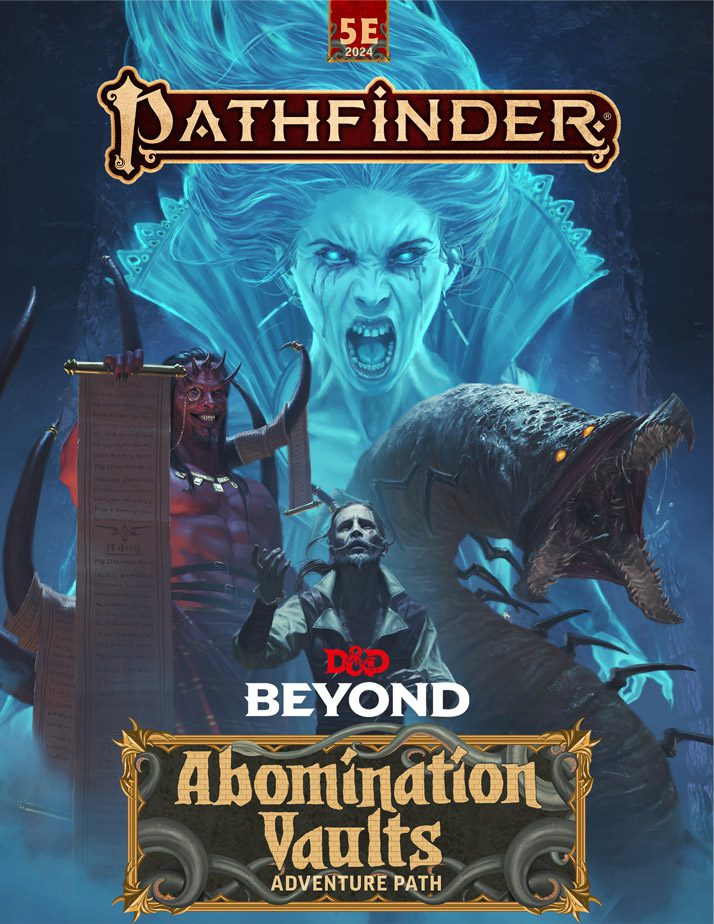Paizo, the people behind Pathfinder and Starfinder, are partnering up with Dungeons and Dragons to distribute one of its most popular campaigns through the digital platform D&D Beyond in a move.
Abomination Vaults, one of the best known campaigns for Pathfinder 2e, is being added to DnDbeyond in 2024 5e format. It’s so well known that it is being adapted into a hack-and-slash video game.
“Evil stirs in the depths of the Abomination Vaults, a sprawling dungeon where the evil sorcerer Belcorra Haruvex attempted to raise an army of monsters hundreds of years ago,” the adventure path’s description states. “Brave heroes must venture into a dungeon full of beasts and traps to prevent a spiteful villain from rising again.”

It’s the first time that a Pathfinder campaign has been formally adapted into Fifth Edition 2024 rules, and a decision that may surprise some fans.
The announcement arrived weeks after WOTC and Call of Cthulhu developer Chaosium announced that they’re releasing Cthulhu by Torchlight, a 5e supplement that adds the Lovecraftian mythos to DnDBeyond exclusively.
The discussion process for the addition of Chaosium and Paizo’s products to DnDbeyond has been ongoing for several months, according to WOTC product manager Laura Hohman. Both companies were “so happy and willing to collaborate and tweak things here and there to fit [DnDbeyond.com’s format”], Hohman told The Fandomentals. She also emphasized that the team overseeing these partnerships are “committed to driving transparency and collaboration forward with the entire community, not just the D&D community.” It’s also part of Wizards of the Coast’s belief that Fifth Edition D&D is for “doing anything” within the TTRPG space.
“Paizo is excited for this new partnership with DnDBeyond and to bring Pathfinder to a new audience,” Paizo narrative lead John Compton told The Fandomentals. He also noted that this introduction of Abomination Vaults was an experiment and that future collaborations were possible if the numbers pan out.
The incorporation of Abomination Vaults also gave Paizo a chance to revisit the originam game and tweak the content, Compton added.
The announcement arrives days after the newly appointed head of D&D Dan Ayoub committed to “building trust” and promoting third-party content creators as part of his new vision for the franchise.
Paizo has a long history with Dungeons and Dragons. The company was initially founded to publish D&D magazines in the early 2000s, only for Wizards of the Coast to decide to not renew the license in 2007. That led to Paizo publishing its own series of adventures, followed by the first edition of Pathfinder. The new game was introduced as a version of D&D, building off of WOTC’s System Reference Document and Open Gaming License. The game would grow to become one of the more prominent competitors in the market, arguably one of the largest competitors to D&D’s market dominance.
While Paizo and Wizards of the Coast share writers and intellectual property, Pathfinder fans have often advocated for D&D players to try Pathfinder in an attempt to play a different (And in their opinion, better) fantasy roleplaying game. So this decision to move a Pathfinder property back into 5e format may surprise some fans. This push became particularly notable after the OGL controversy in 203. Paizo responded to WOTC’s controversial policy changes through an “ORC” license that was system-agnostic and available to all game designers.
Images via Dungeons & Dragons
Have strong thoughts about this piece you need to share? Or maybe there’s something else on your mind you’re wanting to talk about with fellow Fandomentals? Head on over to our Community server to join in the conversation!


